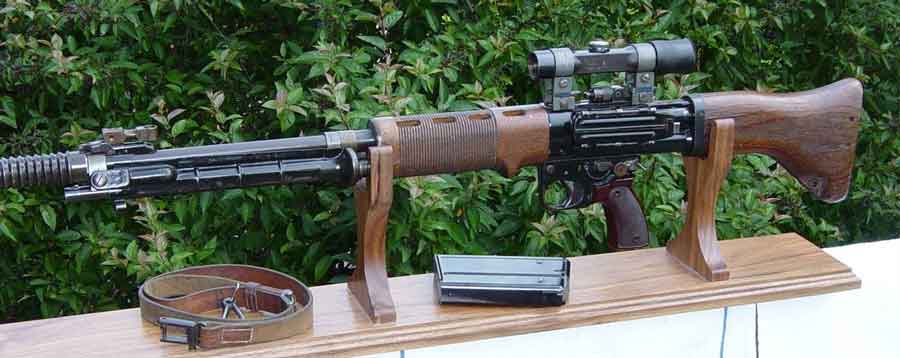FG-42 automatic rifle.
In the strange world of Nazi Germany internal strife and rivalry flourished (was even fostered), and in no sphere was this internal feuding more rife than between the German army and the Luftwaffe. By 1942 the Luftwaffe were encroaching on the preserves of the army to an alarming extent for no other reason than petty wrangling, and whenthe army decided to adopt a selfloading rifle the Luftwaffe decided that it too had to have such a weapon. Instead of following the path followed by the army with its adoption of the kurz round, the Lufwaffe decided instead toretain the standard 7.92-mm (0.312-in)rifle cartridge and asked Rheinmetall to design a weapon to arm the Luftwaffe parachute troops, the Fallschirmjäger.Rheinmetall accordingly designed and produced one of the more remarkable small-arms designs of World War
II.

This was the 7.92-mm (0.312-in) Fallschirmjägergewehr42 or FG 42, a weapon that somehow managed to compress the action required to produce automatic fire into a volume little larger than that of a conventional bolt action. The FG 42 was certainly an eye-catching weapon, for the first examples had a sloping pistol grip, an oddly-shaped plastic butt and a prominent bipod on the forestock, To cap it all there was a large muzzle attachment and provision for mounting a spike bayonet. The ammunition feedwas from a side-mounted box maga-zine on the left, and the mechanism
was gas-operated.
All in all the FG 42 was a complex weapon, but was notinnovative as it wasan amalgam ofseveral existing systems.Needless to say the Luftwaffe took to the FG 42 avidly and asked for more. They did not get them, for it soon transpired that the novelties of the FG 42 had to be paid for in a very complexmanufacturing process that consumedan inordinate amount of time and production facilities.
Second Model:

Thus supply was slow and erratic, and in an attempt to
speed production some simplifications were added. A simpler wooden butt was introduced and the pistol grip was replaced by a more orthodox component.The bipod was moved forward tothe muzzle and other short-cuts were introduced.
It was to no avail, for by the time the war ended only about 7,000 had been made. But it was after the war that the FG 42 made its biggest mark, for many of its design features were incorporated into later designs.
Perhaps the most important of these was the gas-operated mechanism which could fire from a closed bolt position for single-shot fire and from an open bolt for automatic fire, all compressed into a relatively small space.
One thing that was not copied was theside-mounted magazine. This provedto be less than a success in action for not only did it snag on clothing or otheritems but it tended to unbalance the weapon when fired. The FG 42 was a highly advanced design for its day and it incorporatedmany of the features now used on many modern assault rifles. Typical of these was the use of a ‘straight line’ layout from butt to muzzle and the gas operated mechanism already mentioned.
FG42
Calibre: 7.92 mm
Length: 940 mm
Length of barrel: 502 mm
Weight: 4.53 kg
Muzzle velocity: 761 m/s (2,500 ft)
Magazine: 20-round box
Cyclic rate of fire: 750-800 rpm

Source: Enciclopedya Weapons WW2









